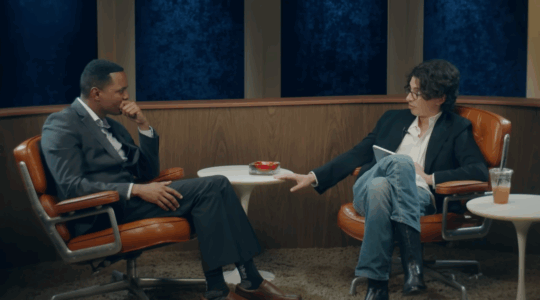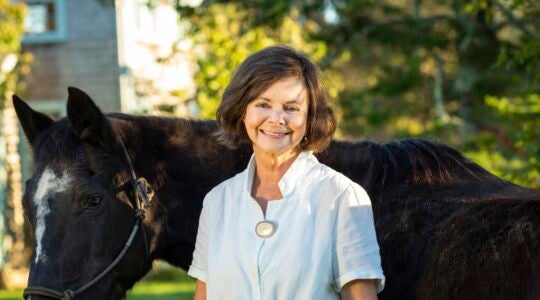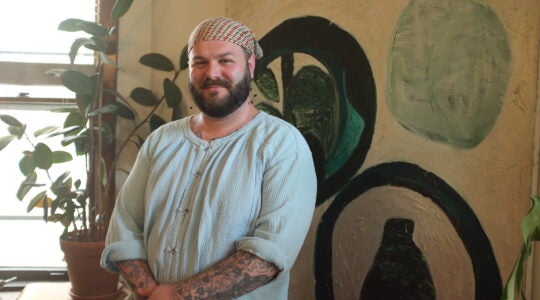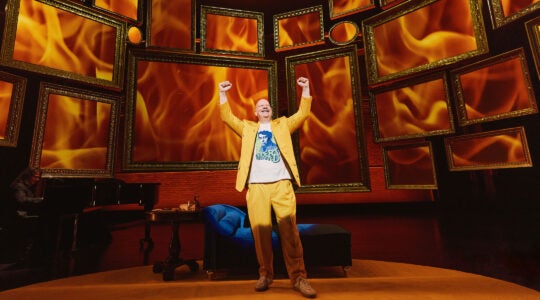Rachel wrote a lovely post below on the Jewish roots of Maurice Sendak, his book, Where the Wild Things Are, and of its filmed version’s director, Spike Jonze.
I was traveling Friday when it opened, so I caught more than my usual two (Washington Post and New York Times) reviews — I ended up reading at least five, and these, positive and negative, melded into a curioisity I satisfied over the weekend with my sons.
My 11-year old, who has a prodigious memory and who hasn’t read the book in ages, noticed that the sea monsters are missing. No one else seems to have noticed. (Okay, I’m shvitzing.)
More than that was missing, oddly enough for a movie that expands ten sentences into 101 minutes. Or, it was missing precisely because Sendak’s original allusions and allegories are filled in by explanation.
It’s too much, perhaps, to say that what was missing was the book’s Jewishness, or Sendak’s Jewishness, but I think the fears he conjures in the books have very much to do with being a first-half-of-the-20th century child of Jewish immigrants; the fears treated by Jonze are quite different, and more sinister in some ways.
This is not to say the film is not a success, although at first Jonze’s substitutions — or imaginings — threaten to drag it into "Afternoon Special" territory, as one of the reviewers I read described it.
The anger the unseen mother expresses in the book, when she sends Max to bed without supper, was (reportedly) shocking at the time of its publication, 1963. It retains an element of shock, because it relates purely to Max’s (wild) actions, or seems to. Max bears its brunt because he occasioned it.
In the movie, the mother, brought to vivid life by Catherine Keener is harried, divorced, trying to impress a boyfriend. Her anger doesn’t have much to do with Max, which makes it less threatening — and more mundane. Of course, she blows up! Don’t we all? But this sacrifices the fundamental, frightening unfairness of the blow-up in the book.
The only significant argument between Sendak and Jonze and his collaborator, writer Dave Eggers, was over Max’s journey to the land of the wild things. Sendak wanted to preserve the transition of Max’s room into a jungle and then an ocean; Jonze and Eggers instead send Max, furious, flying into the suburban night to an industrial riverside, from whence he travels to the land of wild things.
And so Sendak’s Max travels (I believe) to the Europe of the imagining of the child of refugees from that scorched earth. (Sendak’s parents fled the privations of World War I Europe, and relations died in the Holocaust.). Sendak based the wild things on his relatives — the ones who would pinch his cheeks and pronounce "I’ll eat you up!"
This is the frightening conundrum for the children of refugees: The "other place," the place your family fled, is at once familiar and terrifying. The monsters who threatened to consume — eat up — your family are not too unlike your family. Not in moral terms, of course (what child grasps such moral distinctions?), but in how they sound, what they speak, what they eat, how they behave.
The fear, the fury spurring the mother of Sendak’s Max, might be the helplessness a refugee feels in such a world not too long ago, familiar and terrifying and now unfamiliar and terrifying. Sendak’s Max posesses the inclination of every refugee child faced with his parents’ demons: I will defeat these monsters. I will tell them to BE STILL and they will, just as my adoring aunts and uncles heed my commands.
Jonze’s Max deals with his own monsters: His own guilt, his collusion in that most American of tragedies, the break up of the modern American family. Two of the "wild things," Carol and DW (persuasively voiced, respectively, by James Gandolfini and Lauren Ambrose) substitute for his parents. Whereas in the prosaic suburban preamble we are (unfortunately) jolted out of Max’s world and into an adult understanding of family strife, on the island of wild things we witness a divorcce as a child might: Occasioned by arguments that seem weirdly immaterial (who gets to step on whose head), and by the father figure’s baffled jealousies, of Max, and in one hilarious instance, of DW’s pair of bleating, breast-like owls — that jealousy shared, guiltily, by Max.
Sendak’s Max conquers his mother’s fears, makes them tame; Jonze’s Max flees his own fears, occasioned by his parents, especially his father. His wild things devolve into that most American of nightmares: A parent so unsettled by the inherent instability of a family cut off from a broader culture that he threatens to murder his son. (Spoiler alert! Oops.) This is the nightmare borne not of strangers in a distant Old Country, but of American intimates; it is the frontier just beyond the warehouse down past the cul de sac, the Wisconsin death trap.
There lies the integrity of Jonze’s movie: Once it leaves suburban realities, it becomes an indictment of the shattered American social landscape.
Jonze’s ending is melancholy; Max has failed. His fears live on, baying at the moon on a distant island.
Sendak’s Max, by contrast, has triumphed.
Most telling is the very ending: Jonze’s Max returns home to a meal kept hot for him because his mother has been worried sick by his disappearance.
Sendak’s Max returns to a hot dinner brought up to his room. It’s just there.
The mother of Sendak’s Max doesn’t need a motive, a reason, to feed her son. The monsters on the other side are reason enough.
JTA has documented Jewish history in real-time for over a century. Keep our journalism strong by joining us in supporting independent, award-winning reporting.





